Hair loss is more common in men than in women and can affect males as early as their late teens and early 20s. Male pattern hair loss follows the Rule of Decades: 20% of males in their 20s suffer from pattern baldness; in men in their 30s, 30% experience hair loss, and so on.
Men usually experience hair loss at the crown (bald spot at the back of the head), front (receding hairline) and top of the scalp. 95% of all male hair loss cases is due to male pattern hair loss, which is genetically caused by hormones, and is referred to medically as androgenetic alopecia.
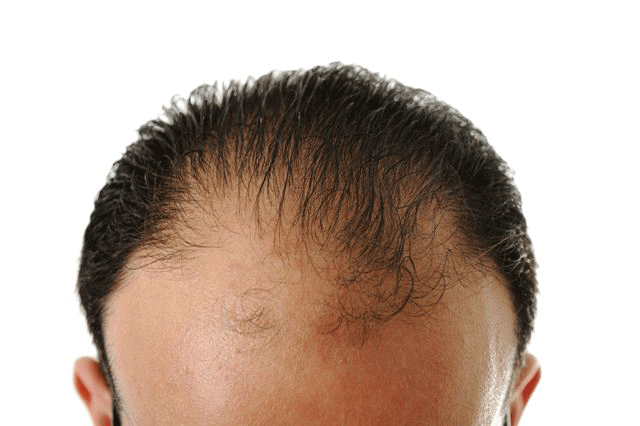
Hair thinning on the male frontal hairline
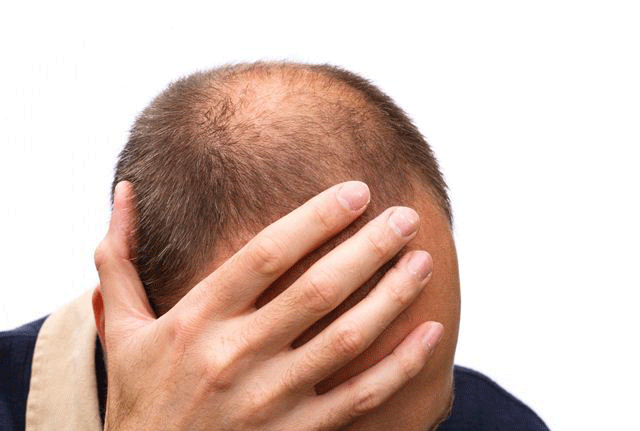
Hair thinning at the crown at the back of the head.
Men have about 100,000 hairs at their peak in their early teens. By the time they first notice hair loss, they have already lost half their hair or about 50,000 hair follicles.
How to Treat Hair Loss in Men
Hair loss does not happen overnight, rather hairs grow, then shed, then grow again. Hair loss occurs when hair grows back progressively thinner in each cycle, until it becomes so thin that it disappears and stops growing altogether. The treatment makes a significant impact on the hair thinning process – instead of hairs growing progressively thinner, hair grows back thicker, even darker.
Over the past seven years, TrichoStem® Hair Regeneration has proven effective in 99% of male patients who receive the treatment. Experience with a wide variety of male pattern hair loss has led to the development of customized treatment plans based on age of onset, degree of hair loss, rate of hair loss and other variables determined during consultation.
TrichoStem® Hair Regeneration is made up primarily of its activator platelet-rich plasma (PRP) that is taken from your own blood prior to the procedure, and ACell’s extracellular matrix as the main active ingredient. Both PRP and extracellular matrix are wound healing materials: the platelets of PRP are what heal cuts, ECM uses the regenerative qualities of porcine bladder for advanced reconstructive surgery. The combined wound healing materials trigger a wound healing response in the scalp that spurs the production of adult stem cells. The response of your own activated stem cells appears to stimulate the hair growth cycle. Hairs that were growing thinner appear to grow thicker, healthier hair, and in the people who have graying hair sometimes become darker hair. TrichoStem® Hair Regeneration does not contain drugs, and has helped many men who did not appear to respond well to finasteride (Propecia) therapy.
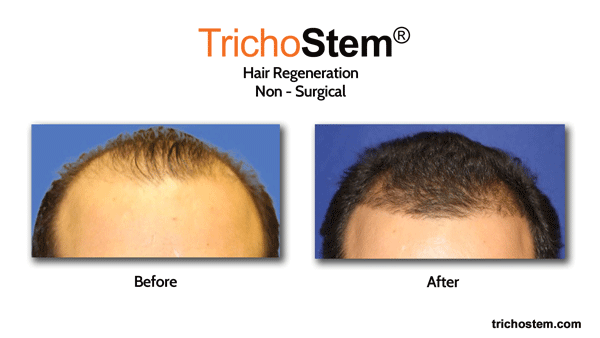
Man who didn’t respond to finasteride (Propecia) gains hair through TrichoStem® Hair Regeneration non-surgical treatment.
How to Stop Hair Loss in Men
Hair loss treatments generally require some maintenance.
Surgical hair transplantation does not stop hair loss, so hair does thin and falls out even after a transplant. If hair transplant patients do not receive additional treatment to manage hair thinning, they will need additional hair transplants until their donor area runs out.
Finasteride (Propecia) is a 5mg pill that is taken daily to stop the enzyme 5 alpha reductase from turning testosterone to dihydrotestosterone (DHT) to reduce hair thinning in DHT-sensitive hair follicles. If daily intake of the pill stops, hair will continue to thin at the rate it was prior to use. Possible sexual side effects of finasteride has discouraged many men to avoid taking this drug. Finasteride is not approved to be taken by women but can be used off label.
Minoxidil (Rogaine) is a topic treatment that doesn’t stop hair from thinning, but does extend the active hair growth phase (anagen) and delays the hair shedding phase (telogen) so more hair is present on the head. Minoxodil needs to be applied twice daily. If use is discontinued, the hair growth cycle reverts to its regular timing, and hair looks the same as it did prior to treatment. Many minoxidil users don’t see enough changes in their hair to bother continuing with twice daily application.
Platelet-rich plasma (PRP) injections for hair loss need regular treatment sessions every month to few months with no clear end point . While PRP is used in TrichoStem® Hair Regeneration, in our clinical experience, using it alone for hair loss treatment produces minimal, varied, and inconsistent results. PRP injections don’t work on everyone.
TrichoStem® Hair Regeneration is a customized plan, with regular follow ups to monitor progress every few months. Depending on hair loss profile, treatments are separated by gaps of 15-18 months to 3-5 years. Most TrichoStem® Hair Regeneration patients avoid a hair transplant completely because the density they receive from the non-surgical treatment often exceeds the results of not one, but two hair transplants. The TrichoStem® Hair Regeneration treatment also costs about half of hair transplant surgery. In patients who have completely lost hair in certain parts of the scalp, a hair transplant can be performed with TrichoStem® Hair Regeneration to increase graft survival, thicken surrounding native hair, and stop continued hair loss.
Longevity of the TrichoStem® Hair Regeneration Treatment for Hair Loss
After 7 years of administering the TrichoStem® Hair Regeneration treatment, its exact longevity appears to be associated with specific hair loss profiles which factors in age of onset, rate of progression, and degree of hair loss. In general for most people with moderate degree of hair loss with later onset and moderate to slow progression, a single treatment can last 2-5 years, and beyond.
Hair Transplants and TrichoStem® Hair Regeneration
The overwhelming majority of TrichoStem® Hair Regeneration patients who were considering hair transplants prior to treatment, have been able to delay or avoid hair transplantation after treatment. TrichoStem® Hair Regeneration has become a true hair transplant alternative because it can provide better hair density than a hair transplant by thickening hair that has thinned, which is why the treatment can exceed the results of not one, but two hair transplant sessions. Nature spaces hair density much closer together than what can be achieved through hair transplantation because close density in a hair transplant will damage adjacent hair follicles, causing more hair loss.
TrichoStem® Hair Regeneration costs about half of a hair transplant, contains no drugs, does not involve surgery, and can be performed in a fraction of the time, and unlike a hair transplant, it can help delay further hair loss.
While TrichoStem® Hair Regeneration can be an alternative to hair transplant, it can also be used in conjunction, or shortly after hair transplant surgery. Combining the wound healing materials of platelet-rich plasma (PRP) and extracellular matrix by ACell helps to heal hair grafts, increase the survival rate of hair grafts, thickens the native hair surrounding transplanted hair, and most of all, manage hair loss progression.
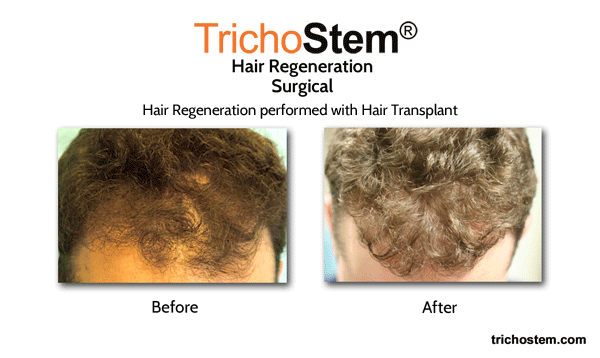
A hair transplant is performed in completely bald areas, with TrichoStem® Hair Regeneration used in conjunction to prevent the need for more hair transplants in the future. The additional treatment thickened surrounding native hair, and also increased the survival rate of transplanted hair.
What Causes Male Pattern Baldness?
DHT
The hormone dihydrotestosterone (DHT) is a major contributor to male pattern hair loss. Dihydrotestosterone (DHT) is a byproduct of testosterone’s interaction with Type II 5-alpha reductase. Type II 5-alpha reductase is contained in the oil glands of hair follicles.DHT shrinks sensitive and susceptible hair follicles. As follicles shrink, hair becomes progressively thinner. Total pattern baldness occurs when thinning hair becomes so miniaturized that it stops growing altogether. Unfortunately, this hair-follicle sensitivity is genetic, shared by men within familial lines. While DHT is present in all men and women, not everyone has the same level of DHT-sensitive hair follicles.
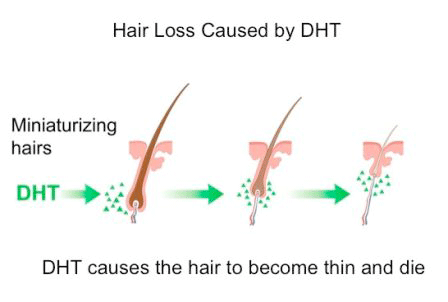
Hair follicles that are sensitive to DHT grow back thinner with each hair growth cycle. If left untreated, these hairs will eventually disappear altogether.
There are areas of the head that are genetically resistant to the effects of DHT, even in the baldest men. These areas are where donor hair is taken during hair transplants. It is important to note that follicular unit extraction (FUE) method of graft harvesting takes donor hair from outside this permanent zone, as this method cannot obtain as many grafts as follicular unit transplantation (FUT), also known as the Strip Method.
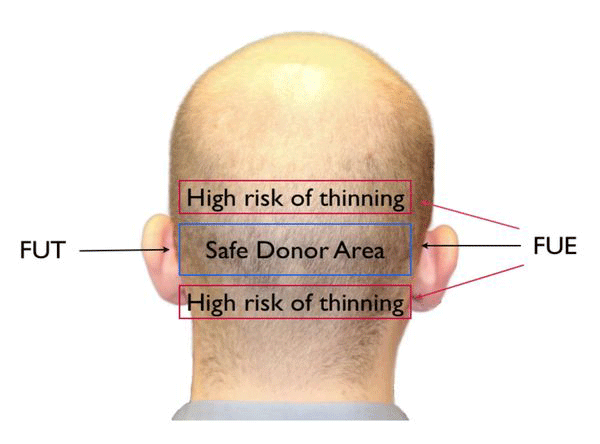
The donor area/permanent zone is an area of hair that is genetically resistant to DHT, so it is not prone to thinning. This limited area is where grafts are taken for hair transplants.
Attempts to Hide Hair Thinning/Hair Loss Makes it More Visible
To compensate for hair loss, some men opt for toupees and “comb-overs” in a more obvious attempt to hide patchy, bald spots.
While some men who choose to shave off remaining hair actually look better bald, others can’t live with baldness.
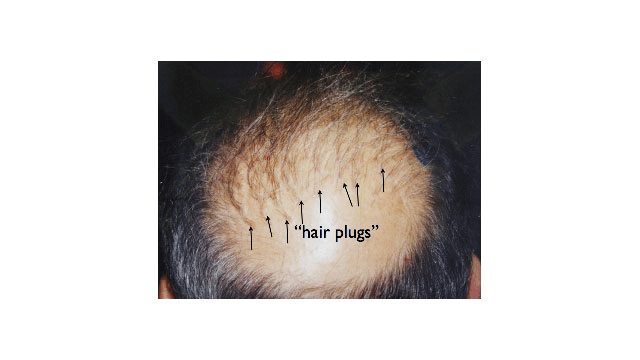
Hair plugs are visible when transplanted hair remains, but native hair around it has thinned out and disappeared. Hair transplants do not stop progressive hair loss, so treatments like TrichoStem® Hair Regeneration are needed with hair transplants to prevent visible hair plugs, and more importantly, prevent the need for expensive, repeat hair transplants.
A common way to hide hair loss, which only draws more attention to it, are visible hair plugs. Hair plugs are not the result of bad hair transplants, rather the result of hair continuing to thin and disappear years after a transplant. Hair Transplants on their own do not stop continued hair loss like the TrichoStem® Hair Regeneration treatment. Hair plugs are actually transplanted hair that are genetically resistant to hair thinning since they are taken from the permanent zone at the back of the head. However, after the transplant, the transplanted hairs remain in place since they do not thin, while the native hair around them gradually thins with each growth cycle, and eventually becomes too thin to be seen, or disappears altogether.
Other Common Causes of Male Baldness:
Alopecia Areata
Alopecia areata is a common autoimmune skin disease which affects approximately 1.7% of the overall population, including more than 4.7 million people in the United States.
The disease can occur in both males and females, with no bias on race or age. Contributing factors that make an individual susceptible to alopecia areata include genetics, stress, hormones, allergies, viruses, and even toxins.
Since alopecia areata can result in hair loss on every part of the body, it can have a psychological impact on those affected. The condition can disrupt a person’s personal and work life, even if it is not life-threatening or contagious.
In the case of alopecia areata, hair follicles are attacked by a person’s own immune system (white blood cells, in particular), somehow mistaking them to be threats to the body. This results in hair loss, which can occur abruptly, sometimes in a matter of days.
Alopecia areata often starts as circular, smooth bald patches on the scalp. Many who have one or two small patches can make a full recovery within two years even without treatment. At times, alopecia areata can progress to total hair loss on the scalp (alopecia totalis) or complete hair loss on the body (alopecia universalis).
How to Prevent Hair Thinning in Men
To get the proper diagnosis of what is causing your hair loss, you can book an appointment at our Manhattan location at (212) 265-8877, or our Garden City, Long Island location at (516) 742-4636, or at Vienna, Virginia office at (703) 356-1336. You may also fill out the contact form below and we will get back to you as soon as we can.
